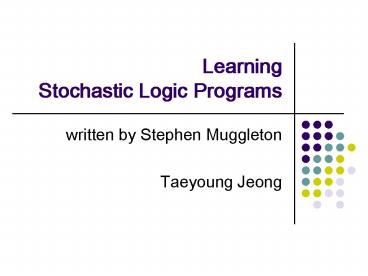Learning Stochastic Logic Programs - PowerPoint PPT Presentation
1 / 23
Title:
Learning Stochastic Logic Programs
Description:
Stochastic, from the Greek 'stochos' or 'aim, guess', means of, relating to, or ... two predicate symbols King' and Human' two constant John' and Arthur' 0.5 : ... – PowerPoint PPT presentation
Number of Views:77
Avg rating:3.0/5.0
Title: Learning Stochastic Logic Programs
1
Learning Stochastic Logic Programs
- written by Stephen Muggleton
- Taeyoung Jeong
2
Contents
- Stochastic
- Logic Programming
- Stochastic Logic Programming
- Reconsideration of Bayes Theorem
- Results
3
Stochastic
- Stochastic, from the Greek "stochos" or "aim,
guess", means of, relating to, or characterized
by conjecture and randomness. A stochastic
process is one whose behavior is
non-deterministic in that a state does not fully
determine its next state. (wikipedia.org,
stochastic) - Fuzzy? Monte-Carlo? Statistic?
4
Logic Program
- Given theory P, set of clauses
- Find a Model M, that satisfies a clause G
5
Logic Program Example
- 1) ancestor(x,y)?parent(x,y)2)
ancestor(x,y)?parent(x,z)?anc(z,y)3) parent(A,B)
4) parent(B,C) - Find u,v that satisfies ancestor(u,v)
6
Proof in LP Resolution
- Assume that for all (u,v), ancestor(u,v) is
false. It is the same to the sentence, false
? ancestor(u,v) - If we prove this sentence is false for all (u,v),
it means that ancestor(u,v) is true for all
(u,v).
7
Proof in LP Resolution
- Refutation Completeness If a (set of) sentence
is not satisfiable, the resolution will always be
able to derive a contradiction.(To prove
Refutation Completeness, we use Herbrands
Theorem, Ground Resolution Theorem, Lifting
Lemma, etc) - If we can derive the contradiction within the
restriction D, that is the prove for it is
satisfiable for D.
8
Logic Program Example again.
- 1) ancestor(x,y)?parent(x,y)2)
ancestor(x,y)?parent(x,z)?anc(z,y)3) parent(A,B)
4) parent(B,C) - Find u,v that satisfies ancestor(u,v)
9
Sample continues
- false?ancestor(u,v)
- substitute u/x1,v/y1 with 2)false?parent(x1,z1)
?ancestor(z1,y1) - with 3) x1/A,z1/B, false?ancestor(B,y1)
- 1) x2/B,y2/y1, false?parent(B,y1)
- 4) y1/c makes, false?true Contradiction!
- linear resolution ltG, C2, C3, C1, C4gt applied.
- u/x1,v/y1 x1/A,z1/B x2/B,y2/y1 y1/c gt
uA, vC
10
Stochastic Logic Program
- Given SLP S, a set of labeled clauses pC, where
C is clause and p is probability. For each
predicate symbol p, sum of probability pp must be
pp 1. - example (complete pp 1)0.5 coin(head)
?0.5 coin(tail) ? - example (incomplete pp lt 1)0.3 likes(X,Y) ?
pet(Y,X), cat(Y)
11
Proof of SLP
- refutation sequence ltG, C1, C2.... gt becomes
lt1G, p1C1, p2C2, .... gt - Every step, pG and qCk makes pqR.
- We can find incomplete probability Q(aS)
?DS,(?a)Q(DS,(?a)), for all derivations DS,(?a)
available.
12
Model of SLP
- We want to find a distributional L-model M, which
is Q(aS)M(a) for each ground term a.
(unreasonable definition?) - Because we dont have the complete information,
we cannot bound Q(aS).
13
Stochastic LP Model Example 1
- 0.5 coin(head) ?0.5 coin(tail) ?
- Q(coin(head)S) 0.5Q(coin(tail)S) 0.5
- 0.5coin(head), 0.5coin(tail) is a model
of S. - 0.4coin(head), 0.6coin(tail) is not a
model of S.
14
Stochastic LP Model Example 2
- Suppose we have in language L,two predicate
symbols King and Humantwo constant John
and Arthur0.5 Human(X) ? King(X)0.5
King(John) - 0.5 Human(John) ? King(John)0.5
King(John)--------------------------0.25
Human(John)
15
Example 2 Truth table(?)
- Q(Human(John)S) 0.25Q(King(John)S) 0.5
- ?(Human(John)?King(John)) ? ?Human(John)?King(Jo
hn)
16
Example 2 goes on
- We cannot say about the incomplete area, because
we dont have full information. - 1Human(John), 0Human(Arthur)1King(John),
0King(Arthur) is a model of S. - 0.1Human(John), 0.9Human(Arthur)0.5King(John),
0.5King(Arthur) is not a model of S.
17
With Bayes theorem
- Bayes Theorem
- Our object Maximize p(SE)
- We will take the random examples, thus p(ES)
?p(eiS) ?Q(eiS)
18
What is good learning?
- Find sentences that covers all the example
- Sentence should be small enough
- Not losing the generality Low derivation cost
(leads to the error!) - Size of sentence and the generality of the
hypothesis is in the relation of
tradeoff.(Learning from Positive Data,
S.Muggleton. 2000)
19
Bayes Theorm cont.
- With logarithm, it is converted into log2p(S)
means number of bits needed to represent S, while
?log2Q(eiS) is to represent derivations. - We can calculate ?Q(eiS) in a short time, with
LP resolution!
20
So the author
- Designed an SLP search strategy, like LP
construction or Parameter estimation, by
redefining the compression function with the
User-defined evaluation function in Progol4.5
21
Works like this
22
Conclusion
- Works efficient, finds meaningful solutions
- Cannot find optimal solutionsa) LP construction
is approximate since it involves greedy
clause-by-clause construction.b) Parameter
Estimation is only optimal in the case that each
positive example has a unique derivation.
23
Reference
- Learning Stochastic Logic Programs. S.Muggleton.
- Learning from Positive Data. S.Muggleton.
- Semantics and derivation from Stochastic Logic
Programs. S.Muggleton. - ltArtificial Intelligence, a Modern Approach. 2nd
editiongt. S.Russell P.Norvig.

























![Investigations on Automatic Behavior-based System Design [A Survey on] Hierarchical Reinforcement Learning PowerPoint PPT Presentation](https://s3.amazonaws.com/images.powershow.com/6219810.th0.jpg?_=20150306026)





